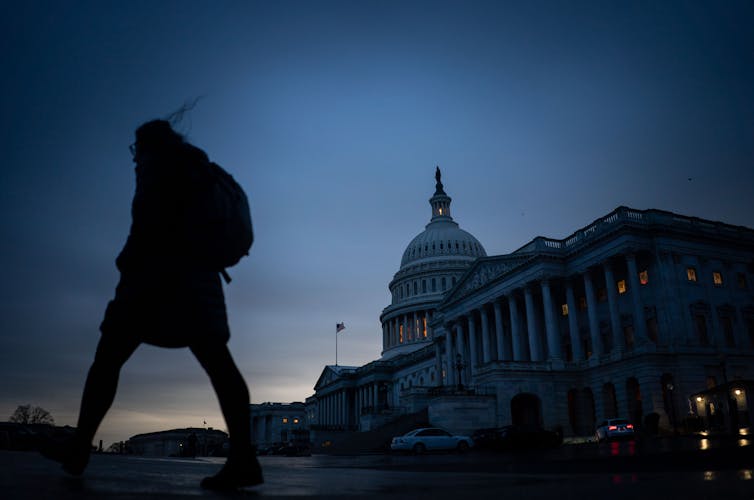How the ‘Holman Rule’ Allows the House to Fast-Track Proposals To Gut Government Programs Without Debate or Much Thought at All


Kent Nishimura / Los Angeles Times via Getty Images
Charles Tiefer, University of Baltimore
The slim Republican majority in the House of Representatives has just voted to give itself a streamlined way to fire civil servants and shut down federal programs it doesn’t like – outside the standard process of review and debate.
This method, known as the Holman rule, has been used in the past by both parties to cloak political decisions in the language and process of saving taxpayers money. It was included in a package of rules approved as the House began its business in January.
As a former acting general counsel of the U.S. House of Representatives and the author of a treatise on congressional procedure, I know that this method has been used in the past to push extreme political agendas through the political process without due consideration for the public interest. And it’s likely to happen again.
Florida Republican Rep. Kat Cammack spoke about the Holman rule’s adoption on the House floor in early January 2023, calling federal officials “unelected bureaucrats, the true, real swamp creatures here in D.C.,” saying they had “run roughshod over the American people without consequence.”
“Today marks our first move, and certainly not our last, to hold them accountable.”
Jacqueline Simon, public policy director of the American Federation of Government Employees, sees the Holman rule differently: “It goes around everything that protects the civil service from political corruption — not just federal employees but entire agencies. It is precisely for theater and to create chaos and disrupt the operation of federal agencies, including law enforcement agencies.”
The rule allows House members to transform the normal process of compiling appropriation bills – normally, lists of amounts of money to be spent – into vehicles to fire government employees and shut down programs they don’t like.
Anything is ripe for cutting with the Holman rule, from environmental protection agencies to government efforts for human rights to existing programs for addressing sales of semi-automatic weapons.
Republican Rep. Kat Cammack says the Holman rule is needed because ‘unelected bureaucrats, the true, real swamp creatures here in D.C.,’ have ‘run roughshod over the American people.’ Tom Williams/CQ-Roll Call, Inc via Getty Images
Fast and furious
Normally, such cuts to staff or programs would have to go through an extensive review process, either to restructure or abolish programs.
That process includes initial drafting of a full-scale bill, subcommittee and full committee hearings and debates, testimony and evidence presented by the president’s administration, press coverage of these steps and adaptation of Congress members’ positions in light of that coverage. Then, votes are held on edits to the bill, known as markups, after which there is a separate committee vote on reporting the bill out to the full House, the drafting of committee report sections by supporters and opponents – and even more after that.
But Holman sidesteps that considered process.
It allows provisions for altering or abolishing programs to be offered to and made a part of appropriation bills, as long as the provision putatively saves money. Under Holman, individual House members offer amendments during full House consideration of a bill on the floor. As long as these amendments cut spending, they are considered proper.
For example, the Inflation Reduction Act of 2022 created a program to improve the technology infrastructure of the IRS and to hire more auditors to focus on the wealthy and corporations. Estimates are the program will cost US$80 billion over a decade. Proposed changes to that program in legislation that goes the normal route through many hearings might get bogged down in debate.
But under Holman, a critic of the program could just drop a change into the must-pass part of the appropriations bill that contains spending for Treasury Department operations and kill or alter the program. No one could stop that from happening unless they chose to vote against the entire appropriations bill, which funds that whole department of the government.
Similarly, the EPA proposes to strengthen regulations limiting the oil and gas industry’s methane emissions, a potent greenhouse gas. A House critic of the methane-control program could just pop into the appropriations bill containing spending on the EPA a Holman rule provision that either cuts the program head’s salary to $1 or terminates the program altogether.
Bipartisan tool – for a time
Historically, the Holman rule, named after Rep. William S. Holman of Indiana, wasn’t a tool of only the Republican Party. It was first developed in 1876 when a Democratic House majority faced a Republican president. I wrote about the history of the Holman rule in my book on congressional practice and procedure.
At the time, the Democratic Party held what would later be called the solid South (today, these areas are usually Republican) and sought to expel Yankee Reconstruction – and repeal the laws behind it. Democrats adopted the Holman Rule to get those repeals of law past President Grant.
The Holman rule could be, and was, put to diverse uses in its early days.
The Congressional Research Service says, “A broad initial construction of the rule by the House resulted in putting a great mass of general legislation upon the appropriation bills.”
The Holman rule was used from 1876 to 1895 and again from 1911 to 1983. It was brought back into use by the GOP in 2017. When Democrats took over the House in 2019, they dropped it.
In one notable attempt in 2017, House Republicans were angry about evaluations of proposed legislation by staff of the nonpartisan Budget Analysis Division of the Congressional Budget Office. So, they used the Holman rule to try to abolish that division and move its employees to another part of its parent agency, making the proposal in a wider budget allocation bill.
Holman allowed disgruntled Republicans to rush their proposal onto the House floor, instead of going through slower, more deliberative processes of examining whether the Budget Analysis Division was fulfilling its mission. The vote to eliminate the division failed, but, significantly, the use at that time of the Holman rule was promoted by the same faction of the Republican party, the Freedom Caucus, that has advocated for using the rule now.
Greasing the skids
There are a number of situations that could lead current House Republicans to use the Holman rule.
First, House Republican leaders may need to unify their party to pass controversial appropriation bills in the face of anticipated unanimous Democratic resistance. Allowing Holman amendments to be proposed by members with extreme views may get needed legislative support from the fringe of the caucus.
House passage of provisions to cut or wipe out programs and whole agencies has two effects. House Republicans can demoralize agency employees who do not know whether to take jobs elsewhere or stay. And House passage may presage passage by the whole Congress.
An attempt by the Senate Democratic majority to kill a House-passed Holman rule provision when it considers legislation sent over from the House would need 60 votes to move ahead. That would require votes from almost a dozen Republican members, which may not be possible to get.
An appropriations bill that contains Holman provisions would then go to conference, which is a temporary committee made up of House and Senate legislators and formed to reconcile differences in legislation passed by both chambers. Senate Democrats may go along, even with objectionable Holman or other provisions, to get buy-in from all the factions of the House Republican party needed for passage of the appropriations bill and avoidance of a government shutdown.
Which brings us full circle to where the Holman rule started, with the southern Democrats’ aim to force through House provisions that Republican President Ulysses S. Grant did not want.
Would President Joe Biden veto all the appropriation bills that have any Holman rule-passed provisions?![]()
Charles Tiefer, Professor of Law, University of Baltimore
This article is republished from The Conversation under a Creative Commons license. Read the original article.

